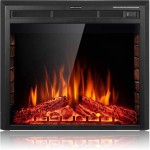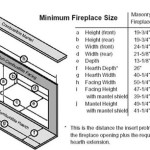Fireplace Wood Burning Inserts: Efficiency, Aesthetics, and Installation
Fireplace wood-burning inserts represent a significant upgrade to traditional masonry fireplaces, offering enhanced heating efficiency, improved aesthetics, and greater control over combustion. These self-contained units are designed to be installed within an existing fireplace opening, transforming an often inefficient and drafty hearth into a powerful and controllable heat source. This article will explore the key aspects of wood-burning inserts, including their benefits, considerations for selecting the right model, installation procedures, and maintenance requirements.
Traditional open-hearth fireplaces, while aesthetically pleasing, are notoriously inefficient at heating a home. A considerable amount of heat escapes up the chimney, often drawing warm air out of the house and creating a negative pressure environment. Wood-burning inserts address this issue by utilizing a closed combustion chamber and a network of baffles and air channels to maximize heat extraction from the burning wood. This significantly reduces heat loss up the chimney and increases the amount of heat radiated into the room.
Improved Heating Efficiency
The primary advantage of a wood-burning insert is its superior heating efficiency compared to an open fireplace. Modern inserts are designed to burn wood more completely, extracting a greater proportion of the energy stored within the fuel. This is achieved through several design features. First, the closed combustion chamber allows for better control over airflow, ensuring a more complete and consistent burn. Second, many inserts incorporate secondary combustion systems that burn off the gases and particulate matter produced during the initial combustion process, further increasing efficiency and reducing emissions.
Third, the use of baffles and heat exchangers helps to extract more heat from the exhaust gases before they are released into the chimney. These features work in conjunction to significantly improve the overall heating efficiency of the fireplace. While an open fireplace may achieve efficiencies of only 5-10%, a modern wood-burning insert can reach efficiencies of 70-80% or higher. This translates to a substantial reduction in wood consumption and a corresponding decrease in heating costs.
The increased efficiency of wood-burning inserts also contributes to a more comfortable and consistent indoor temperature. Unlike open fireplaces, which tend to produce uneven heat distribution, inserts radiate heat more evenly throughout the room, creating a warmer and more comfortable environment. Many models also offer features such as adjustable blowers that circulate warm air further into the room, ensuring that the entire space is heated effectively.
Aesthetic Enhancement and Design Options
Beyond their functional benefits, wood-burning inserts also offer significant aesthetic improvements over traditional fireplaces. Available in a wide range of styles, finishes, and sizes, inserts can be customized to complement the existing decor of any home. From traditional cast iron designs to sleek and modern stainless steel models, there is an insert to suit virtually any taste.
The firebox itself is typically enclosed behind a ceramic glass door, providing a clear and unobstructed view of the flames. This creates the ambiance of a traditional fireplace while also preventing sparks and embers from escaping into the room. Many inserts also incorporate decorative features such as simulated brick liners, ornate grates, and customizable trim options, further enhancing their visual appeal.
Furthermore, wood-burning inserts can often revitalize a fireplace that has fallen into disrepair. Cracks in the masonry, damaged fireboxes, and unsightly soot stains can all be concealed by the insert, giving the entire fireplace a renewed and updated appearance. This can be a particularly attractive option for homeowners who want to maintain the character of their existing fireplace while also improving its functionality and aesthetics.
The ability to customize the appearance of a wood-burning insert ensures that it seamlessly integrates into the existing architectural style of the home. Homeowners can select from a variety of finishes, including matte black, brushed nickel, and porcelain enamel, to match the color scheme and design aesthetic of the room. Additionally, many manufacturers offer a range of accessories, such as decorative surrounds and hearth extensions, that further enhance the overall appearance of the fireplace.
Installation and Safety Considerations
Proper installation is crucial for the safe and efficient operation of a wood-burning insert. It is generally recommended that installation be performed by a qualified professional who is familiar with local building codes and safety regulations. The installation process typically involves several steps, including preparing the existing fireplace opening, installing a flue liner, connecting the insert to the flue, and sealing the perimeter of the insert to prevent air leaks.
The first step in the installation process is to thoroughly inspect the existing fireplace and chimney to ensure that they are in good condition and capable of supporting the weight of the insert. Any cracks, leaks, or other damage should be repaired before proceeding with the installation. The fireplace opening must also be properly sized to accommodate the insert, ensuring that there is adequate clearance around the unit for proper ventilation.
A crucial component of the installation process is the installation of a flue liner. The flue liner is a metal pipe that extends from the insert to the top of the chimney, providing a safe and efficient pathway for the exhaust gases to escape. The liner must be properly sized to match the insert's flue outlet and must be securely connected to both the insert and the chimney. In many cases, existing clay tile liners in the chimney are insufficient and must be replaced with a stainless steel liner specifically designed for wood-burning appliances. This is critical for safety and compliance with building codes.
Once the flue liner is installed, the insert can be carefully slid into the fireplace opening and connected to the flue. The perimeter of the insert must then be sealed with a high-temperature sealant to prevent air leaks and ensure that all exhaust gases are directed up the chimney. The final step is to test the insert to ensure that it is operating properly and that there are no leaks or other issues.
Safety is paramount when operating a wood-burning insert. It is essential to follow all manufacturer's instructions and to adhere to local building codes and safety regulations. Regular maintenance, including chimney cleaning and inspection, is also crucial for ensuring the safe and efficient operation of the insert. It is recommended to have the chimney inspected and cleaned at least once a year by a qualified chimney sweep to remove any creosote buildup that could pose a fire hazard.
Furthermore, it is important to use only seasoned, dry wood in the insert. Burning wet or unseasoned wood can produce excessive smoke and creosote, which can increase the risk of chimney fires and reduce the efficiency of the insert. Seasoned wood should be stored in a dry, well-ventilated area for at least six months to ensure that it is properly dried before burning.
Carbon monoxide detectors should be installed in the home to provide an early warning of any potentially dangerous carbon monoxide leaks. It is also important to educate all members of the household about the safe operation of the insert and the importance of following safety precautions.
In summary, fireplace wood-burning inserts offer a compelling combination of efficiency, aesthetics, and safety. By understanding the key aspects of these appliances, homeowners can make informed decisions about selecting the right model, ensuring proper installation, and maintaining safe operating practices.

Wood Burning Fireplace Inserts 101 Mf Fire

Why A Wood Burning Fireplace Insert Bethesda Md Service

Wood Burning Fireplace Inserts Insert Installation

Ventis Hei240 Wood Burning Insert Rockford Chimney

T25i Timberwolf Wood Fireplace Insert Hearth Stove Patio

Stuv 16 In Z Wood Burning Insert Or Zc Fireplace Mazzeo S Stoves Fireplaces

Wood Inserts We Love Fire

Quadra Fire Expedition I Wood Insert Fireside Hearth Home

Wood Inserts Fireplace Xtrordinair Made In America

Why A Wood Burning Fireplace Insert Bethesda Md Service
Related Posts








